September 2023
The global last mile delivery transportation market size accounted for USD 185.76 billion in 2025 and is forecasted to hit around USD 446.29 billion by 2034, representing a CAGR of 10.23% from 2025 to 2034. The North America market size was estimated at USD 61.59 billion in 2024 and is expanding at a CAGR of 9.68% during the forecast period. The market sizing and forecasts are revenue-based (USD Million/Billion), with 2024 as the base year.
The global last mile delivery transportation market size was calculated at USD 169.95 billion in 2024 and is predicted to increase from USD 185.76 billion in 2025 to approximately USD 446.29 billion by 2034, expanding at a CAGR of 10.23% from 2025 to 2034.
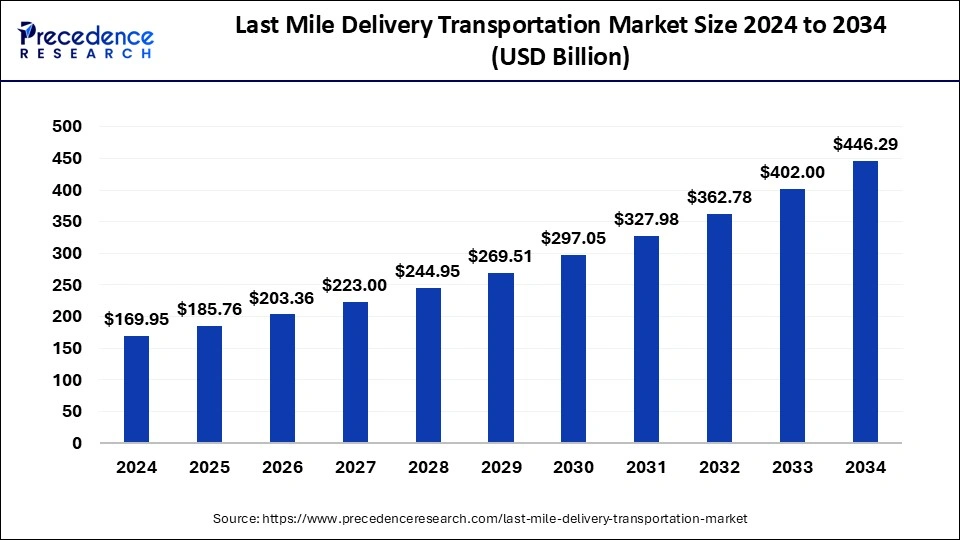
The U.S. last mile delivery transportation market size was exhibited at USD 32.61 billion in 2024 and is projected to be worth around USD 85.61 billion by 2034, growing at a CAGR of 10.24% from 2025 to 2034.
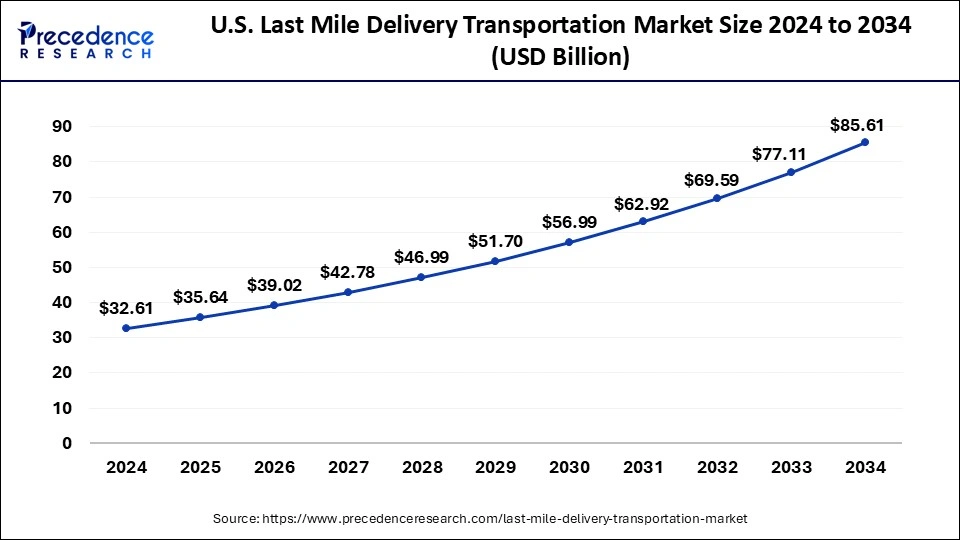
North America dominated the last mile delivery transportation market in 2024. North America has well-developed transportation infrastructure, including road networks, highways, airports, and distribution centers, which support efficient last mile delivery operations. The presence of modern logistics facilities and fulfillment centers enables logistics providers to streamline delivery processes and meet customer expectations for timely and cost-effective deliveries. The rapid growth of e-commerce and online retailing has fueled the demand for last mile delivery services in North America. With the increasing popularity of online shopping platforms such as Amazon, Walmart, and Target, consumers expect fast and efficient delivery of their purchases, driving the need for reliable last mile logistics solutions.
Asia Pacific is observed to expand at the fastest rate during the forecast period. The region is experiencing rapid urbanization, leading to dense populations and increased demand for goods and services in urban areas. With a large and growing urban population, there is a high volume of last mile deliveries required to meet the needs of consumers, businesses, and e-commerce platforms. The rising disposable income and expanding middle class in Asia Pacific have led to increased consumer spending on retail goods, groceries, and other products. As more people gain access to online shopping and digital payment methods, the demand for home delivery services has surged, particularly in urban areas where convenience is valued.
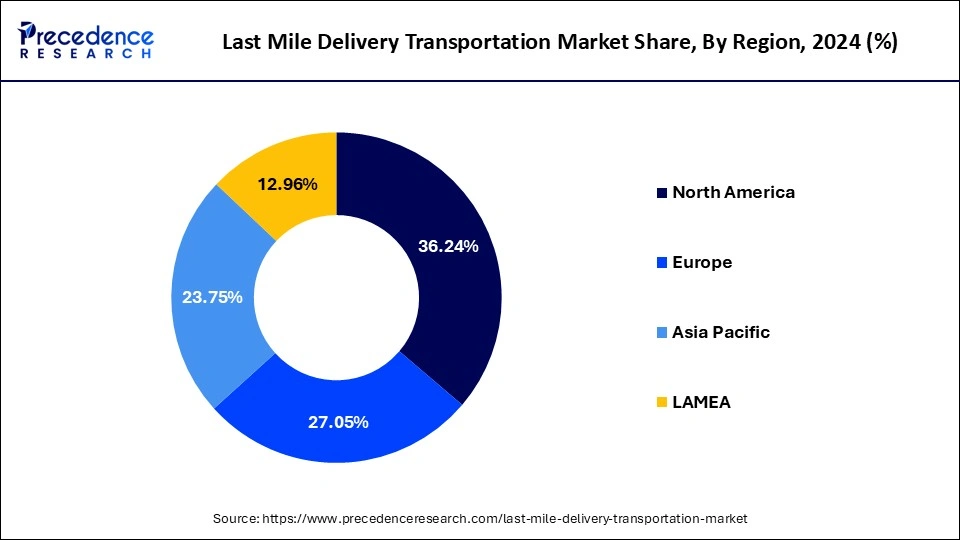
Last mile delivery is also called as logistic of last mile which comprise of transportation of services and goods to final doorstep of customer from the distribution hub. The main goal of this delivery system is to provide the demanded goods & services to the customer’s demanded location within the time frame with a predefined rate and in proper condition. Also, the last mile delivery business is refined and is likely to reach heights in forthcoming time period. Many shoppers and retailers are now focusing more towards the last mile logistics, which will help them stand different in the market. Furthermore, Amazon prime has transformed itself into an online retail distribution channel where, the goods & services demanded are delivered to the customer in decided time line with proper condition. In addition, coming to the rural area, the delivery points are at a certain distance and the parcel rates are low comparatively, where the market of last mile delivery is impacted. Moreover, the inefficiencies and costs of market has further been impacted by continuous growth in the online distribution channels in the retail sales of U.S., which will gradually increase the number of parcels, and this will lead to rise in expectations of customer for faster and free delivery system & services.
Along with the rise in global shipment via digitally advanced supply chains and Omni channel modes, last mile strategies which are ultramodern in nature are getting more pivotal to shippers and customers. In addition, various service providers are observing integration and process standardization changes, buying preferences of guests, and preferred mode of delivery which is impacting new priorities of investment.
The developments which are technological and are under the last mile delivery scope is redefining the delivery transportation of last mile. Also, few of the progressions that are estimated to make inroads in the market comprise of uptake of electric vehicles among mounting environmental concerns, autonomous delivery vehicles and entry of semiautonomous vehicles. Therefore, such innovations are likely to be fulfilled with stringent guidelines related to emission and thus diminish delivery costs owing to which, the entry of these technologies within the current market landscape could be earlier than expected.
The impact of the COVID-19 pandemic on the growth of the global last mile delivery transportation market was quite negative during 2020. This had impacted each and every vertical of industry. The supply chain disruptions and trade restrictions had adverse effects on the growth of the global last mile delivery transportation market.
The factors such as growing middle class population in developed and developing regions are driving the growth of the global last mile delivery transportation market. The rapid industrialization and urbanization and expansion of the logistics industry is supporting the growth of the global last mile delivery transportation market.
One of the prominent factors driving the growth of the global last mile delivery transportation market is the rising penetration of the internet and usage of mobile phones. The growing e-commerce sector is also boosting the growth of the global last mile delivery transportation market.
On the other hand, the regulations imposed by government authorities for control of carbon emissions and greenhouse gases emissions is a major challenge for the expansion of the global last mile delivery transportation market. Moreover, the well-established charging infrastructure for electric vehicles is supporting the development of last mile delivery transportation market.
| Report Coverage | Details |
| Growth Rate from 2025 to 2034 | CAGR of 10.23% |
| Market Size in 2025 | USD 185.76 Billion |
| Market Size by 2034 | USD 446.29 Billion |
| Largest Market | North America |
| Fastest Growing Market | Asia Pacific |
| Base Year | 2024 |
| Forecast Period | 2025 to 2034 |
| Segments Covered | Vehicle, Cargo, End User, Ownership, Solution, Region |
| Regions Covered | North America, Europe, Asia-Pacific, Latin America, and Middle East & Africa |
The two wheelers segment dominated the last mile delivery transportation market in 2024. Two-wheelers, such as motorcycles, scooters, and bicycles, offer superior agility and maneuverability compared to larger vehicles like cars or trucks. This enables delivery personnel to navigate through congested urban areas, narrow streets, and tight spaces more efficiently, reducing delivery times and improving overall productivity.
Two-wheelers are generally more affordable to purchase, operate, and maintain than four-wheeled vehicles. They have lower upfront costs, fuel consumption, and maintenance expenses, making them a cost-effective option for last-mile delivery operations, especially for small and medium-sized businesses with limited budgets.
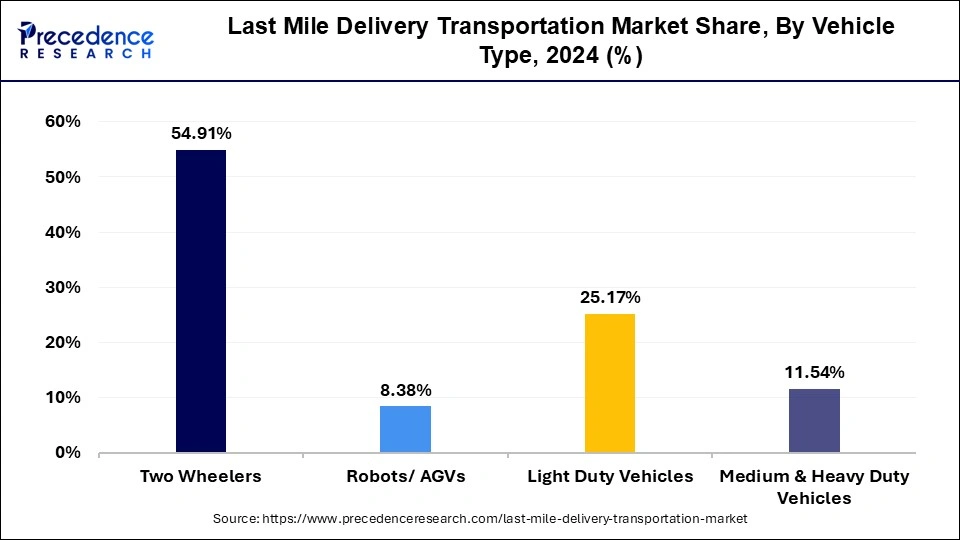
Global Last Mile Delivery Transportation Market, By Cargo Type, 2022-2024 (USD Billion)
| By Cargo Type | 2022 | 2023 | 2024 |
| Two Wheelers | 80.4 | 86.6 | 93.3 |
| Robots/ AGVs | 9.2 | 11.5 | 14.2 |
| Light Duty Vehicles |
37.5 | 40.0 | 42.8 |
| Medium & Heavy Duty Vehicles |
15.8 | 17.7 | 19.6 |
The dry goods segment held the largest share of the last mile delivery transportation market in 2024. Dry goods, including consumer products such as electronics, clothing, household goods, and non-perishable food items, constitute a significant portion of e-commerce orders. The growing popularity of online shopping and direct-to-consumer delivery services has led to a surge in demand for last mile transportation services for dry goods.
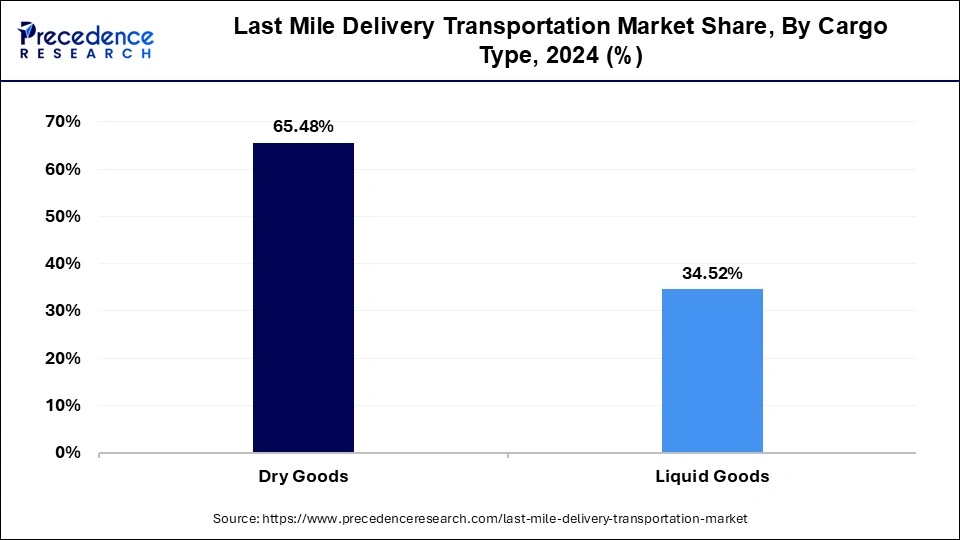
Dry goods encompass a wide range of products that do not require refrigeration or special handling during transportation. This makes them well-suited for various modes of last mile delivery, including traditional delivery vans, trucks, bicycles, and even drones. The versatility of dry goods allows for efficient and cost-effective transportation solutions in urban, suburban, and rural areas.
Global Last Mile Delivery Transportation Market, By Cargo Type, 2022-2024 (USD Billion)
| By Cargo Type | 2022 | 2023 | 2024 |
| Dry Goods | 93.8 | 102.1 | 111.3 |
| Liquid Goods | 49.2 | 53.7 | 58.7 |
The within 2 days segment dominated the last mile delivery transportation market with the largest share in 2024 and is likely to continue its growth trajectory over the studied period. This is mainly due to the increasing consumer desire for same-day or next-day delivery. Within 2 days delivery reduces transportation charges and enhance consumer satisfaction. Advanced technologies, such as tracking and monitoring and route optimization solutions, are enabling faster delivery, supporting segmental growth.
Global Last Mile Delivery Transportation Market, By Delivery Speed, 2022-2024 (USD Billion)
| By Delivery Speed | 2022 | 2023 | 2024 |
| Within 2 Days | 91.0 | 99.9 | 109.9 |
| 2-5 Days |
27.7 | 29.9 | 32.4 |
| 5-10 Days |
16.0 | 17.1 | 18.4 |
| More than 10 Days |
8.3 | 8.8 | 9.3 |
The FMCG products segment accounted for the largest market share in 2024. The increased trend of online grocery shopping is a major factor that supported the segment’s dominance. Some FMCG products, especially edible ones, have limited shelf life. Thus, they require fast and efficient delivery to reach consumers on time.
The food delivery segment is projected to expand at the fastest rate in the coming years. The segmental growth is attributed to the increasing food delivery platforms. With the changing lifestyles, the consumption of packaged, ready-to-eat food is increasing. Since food items have short shelf life, they require last-mile delivery services to reach consumers quickly. Moreover, the expansion of cloud kitchens contributes to segmental growth.
The third party logistics (3PL) segment held the dominant share of the market in 2024 and is projected to grow at the fastest rate during the projection period. This is mainly due to the increasing demand for outsourced delivery services. Outsourcing last-mile delivery to 3PLs is cost-effective, especially for businesses with fluctuating delivery volumes. 3PLs provide flexible solutions, which enable businesses to adjust their delivery capacity.
Global Last Mile Delivery Transportation Market, By Ownership, 2022-2024 (USD Billion)
| By Ownership | 2022 | 2023 | 2024 |
| In-house |
49.2 | 53.0 | 57.1 |
| Third Party Logistics (3PL) |
93.7 | 102.8 | 112.8 |
By Vehicle Type
By Cargo Type
By Delivery Speed
By End Use
By Ownership
By Geography
For inquiries regarding discounts, bulk purchases, or customization requests, please contact us at sales@precedenceresearch.com
No cookie-cutter, only authentic analysis – take the 1st step to become a Precedence Research client
September 2023
February 2025
March 2025
January 2025